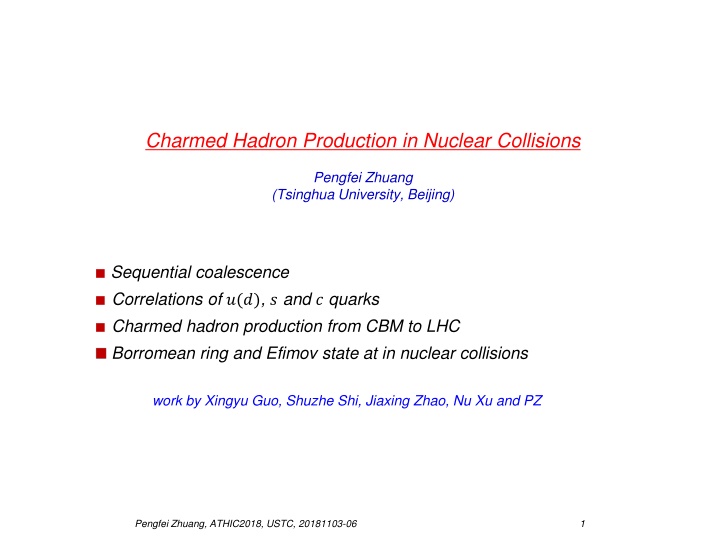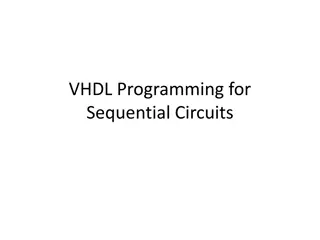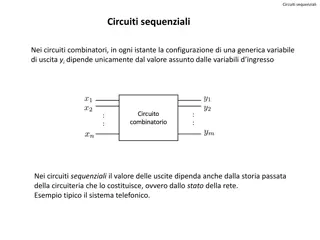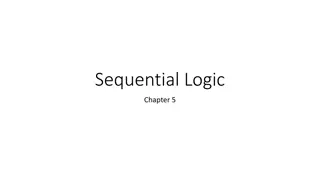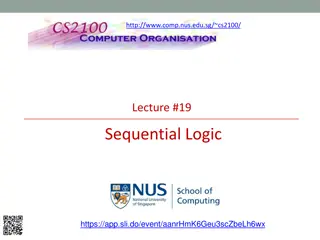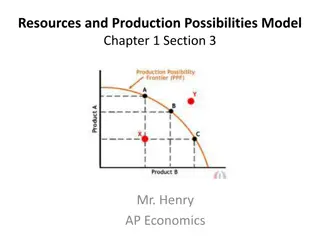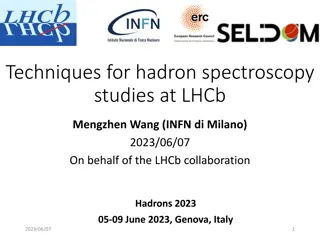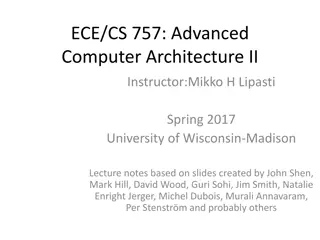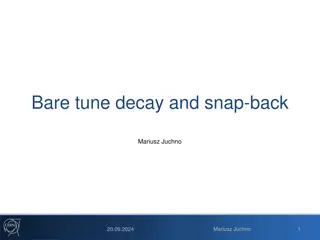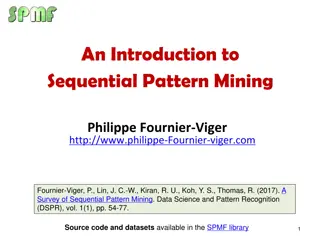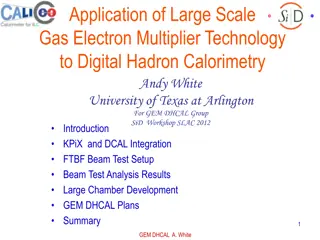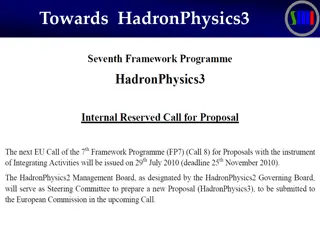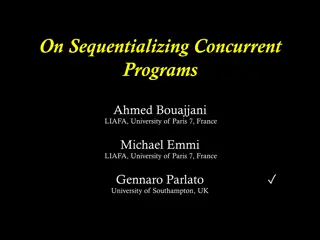Sequential Coalescence Model in Charmed Hadron Production
Research by Pengfei Zhuang explores the sequential coalescence correlations of charmed quarks leading to hadron production in nuclear collisions. The model involves sequential production temperature determination, QGP evolution time calculation, and coalescence process, shedding light on hadronization challenges in physics.
Download Presentation

Please find below an Image/Link to download the presentation.
The content on the website is provided AS IS for your information and personal use only. It may not be sold, licensed, or shared on other websites without obtaining consent from the author.If you encounter any issues during the download, it is possible that the publisher has removed the file from their server.
You are allowed to download the files provided on this website for personal or commercial use, subject to the condition that they are used lawfully. All files are the property of their respective owners.
The content on the website is provided AS IS for your information and personal use only. It may not be sold, licensed, or shared on other websites without obtaining consent from the author.
E N D
Presentation Transcript
Charmed Hadron Production in Nuclear Collisions Pengfei Zhuang (Tsinghua University, Beijing) Sequential coalescence Correlations of ?(?), ? and ? quarks Charmed hadron production from CBM to LHC Borromean ring and Efimov state at in nuclear collisions work by Xingyu Guo, Shuzhe Shi, Jiaxing Zhao, Nu Xu and PZ Pengfei Zhuang, ATHIC2018, USTC, 20181103-06 1
Hadronization Hadronization in vacuum a non-perturbative process, unsolved problem in physics Hadronization of quark matter statistical distribution at freeze-out: P.Braun-Munzinger, J.Stachel, J.Wessels and N.Xu, PLB344, 43(1995) coalescence (recombination) models: V.Greco, C.Ko and P.Levai, PRL90, 202302(2003) R.Hwa and C.Yang, PRC70, 024905(2004) ??????~ ??????(?,?)??(?1,?1)? ?(?2,?2) Two assumptions 1) the coalescence probability (Wigner function) ? ?,? ~? ?2 ?2? ?2 ?2with parameters ? and ? 2) all the hadrons (light and heavy) are created at ?? Limit: quarkonia at finite temperature Schroedinger equation with lattice simulated potential H.Satz, JPG32, R25(2006) X.Guo, S.Shi and PZ, PLB718, 14392012) 1) sequential suppression ??/?> ?? ??? charmed hadrons are sequentially produced ! 2) calculable Wigner function ? ?,? = ?4?? ????(? +? 2)? (? ? 2) Pengfei Zhuang, ATHIC2018, USTC, 20181103-06 2
Sequential coalescence model Step 1: Sequential production temperature from 2- (3-) body Dirac equations from 2-body binding energy ?(?) and wave function ?(?) production temperature ? ?? = 0 Step 2: Sequential production time from hydrodynamics for QGP evolution production time ?? ?,?? Step 3: Sequential coalescence ?~ ??????(?,?)??(?1,?1)? ?(?2,?2) Pengfei Zhuang, ATHIC2018, USTC, 20181103-06 3
Step 1: Dirac equations ? = 0: H.Crater, J.Yoon and C.Wong, PRD79, 034011(2009) O.Kaczmarek, EPJC 61, 811(2009) ? = ? 1.20 1.15 1 ?? ?0 ? ??/?? S.Shi, X.Guo and PZ, PRD88, 014021(2013) Pengfei Zhuang, ATHIC2018, USTC, 20181103-06 4
Step 2: Hydrodynamic equations Sequential production time ideal hydrodynamics: ?????= 0 + ????= 0 ?( ?|??) ?,?,? ? ?0 ?? ??/?< ???< ??0 < ? ?< ??,?,? Pengfei Zhuang, ATHIC2018, USTC, 20181103-06 5
Step 3: Coalescence ??????? 2?3 Hydrodynamics ?4??4? 2?3???1,?1? ??2,?2? ?,? Thermalization ?? ?2????= ? Dirac equations ? ?,? = ?4?? ????(? +? 2)? (? ? strange quark ?: equilibrium distribution with strangeness fugacity 2) light quarks ? and ?: equilibrium distribution ???? ??= ?? ?????/?+1 ??= ?(???? ??)/?+1 ??= 0.85 ?? ???? 1 ?? ??? STAR Collaboration. Phys. Rev. C79,034909(2009) H.Satz et al. Int. J. Mod. Phys. E26, 1750081(2017) Pengfei Zhuang, ATHIC2018, USTC, 20181103-06 6
Charm conservation K.Zhou, Z.Chen, C.Greiner and PZ,. PLB758, 434(2016) Charm quark number ??is conserved in HIC at RHIC and LHC ! If all charmed hadrons are simultaneously produced, the charm conservation is introduced via a normalization constant, the same effect on all the charmed hadrons ! P.Braun-Munzinger and J.Stachel, PLB490, 196(2000) M.Gorenstein, A.Kostyuk, H.Stoecker and W.Greiner, PLB509, 277(2001) Y.Oh, C.Ko, S.Lee and S.Yasui, PRC79, 044905(2009) S.Plumari, V.Minissale, S.Das and V.Greco, EPJC78, 348(2018) If charmed hadrons are sequentially produced, however, more charm quarks are i nvolved in the earlier production and less in the later production, 1 1 ???/??(~90%) 1 (???+??0)/??(~60%) ??? ?? ??? ?0 ??? ? ??=???????? ? ??? ????? ?????? ????? ? ??? ????? ?????? ?? = Pengfei Zhuang, ATHIC2018, USTC, 20181103-06 7
Continuous charm quark thermalization ??= ????? ??? ? + ????? ? ? ???? ?? ??? = ??(??)??(?? ?)cosh ? ? 0.4,0.6 0.5,0.5 0.6,0.4 ?? ?0 ? ?,? = Normalized rapidity and transverse momentum distributions with PYTHIA8 Pengfei Zhuang, ATHIC2018, USTC, 20181103-06 8
Strangeness enhancement Strangeness enhancement in heavy ion collisions P.Koch, B.Muller and J.Rafelski, Phys. Rept. 142, 167(1986) Strong ??/?0enhancement at RHIC and LHC L.Zhou [STAR], NPA967, 620(2017) J.Adam et. al. [ALICE], JHEP 1603, 082(2016) ??enhancement via strangeness enhancement M.He, R.Fries and R.Rapp, PRL110, 112301(2013) there is still a sizeable difference between strangeness enhancement and data. Pengfei Zhuang, ATHIC2018, USTC, 20181103-06 9
Correlation between strangeness enhancement and charm conservation ??enhancement by strangeness enhancement results in ?0suppression by charm conservation ! an extra ??/?0enhancement ! J.Zhao, S.Shi, N.Xu and PZ, arXiv: 1805.10858 RHIC LHC Solid lines: with charm conservation, Dashed lines: without charm conservation Opposite charm conservation effect on ??/?0and ?/?0, depending on the production sequence. Pengfei Zhuang, ATHIC2018, USTC, 20181103-06 10
Correlation between strangeness enhancement and baryon density Baryon density effect ???? ??,? ??,?= ??= ?(???? ??/3)/?+1 ?????/?+ 1 at high baryon density, more ? and ? quarks, less ? and ? quarks, and probably ? ?< ? ?! Quark number density at ? = 0: Strangeness enhancement at high ??! ??(? ?) enhancement and ?0(? ?) supression! ??/?? ? pp limit J.Zhao, S.Shi, N.Xu and PZ, in progress Pengfei Zhuang, ATHIC2018, USTC, 20181103-06 11
??/?0 ? J.Zhao, S.Shi, N.Xu and PZ, in progress Significant strong ??/?0enhancement at about ? = 10 GeV where the baryon density is the largest. The decreasing ratio at very low ? is due to the disappearance of s-quark thermal production, or the disappearance of the QGP fireball. Pengfei Zhuang, ATHIC2018, USTC, 20181103-06 12
Comparison with ?/? J.Zhao, S.Shi, N.Xu and PZ, in progress The behavior of ??+/?0(?? / ?0) is similar to ?+/?+(? /? ) . The two peaks locate at the largest baryon density. Pengfei Zhuang, ATHIC2018, USTC, 20181103-06 13
Significant ??and ???enhancement in AA Why ???and ????in AA at LHC ? 1) ?? 100, ? ??? ~ ??2, It is most probable to study ??properties and discover ???? in AA at LHC. ? ???? ~ ??3! 2) the discovery of ????is a unique signal of QGP. 3) Exotic quantum states at quark level. Results: ???: effective cross section per binary collision ??= ???????? ?? ??? ??= 61 ?? ?? ? + ? ?? ??= 412 ?? ?? ?? + ?? ?? ??? ???= 2.76 TeV ??? ???= 14 TeV ! J.Zhao, H.He and PZ, PLB771,349(2017) ????: effective cross section per binary collision ???= ???????? ??? ??? ???= (0.06 0.13) ?? ?? ? + ? ?? ???= 7 TeV ! ??= 9 ?? ?? ?? + ?? ?? ??? ???= 2.76 TeV ??? H.He, Y.Liu and PZ, PLB746, 59(2015) ???and ????are extremely enhanced in nuclear collisions at LHC! Pengfei Zhuang, ATHIC2018, USTC, 20181103-06 14
????as a Borromean Ring and an Efimov State Efimov state is introduced in nuclear physics, PLB33, 563(1970). It was firstly discovered in cold atom gas, T.Kraemer et al., Nature 440, 315(2006). Is it possible to realize Efimov state at quark level? In vacuum, no, because of the long range interaction. At finite temperature, probably yes, due to the screened quark potential. Borromean ring short range potential at high T ! ?? ??+1= ?2?/?0= 515, Efimov states ! J.Zhao and PZ, PLB775,84(2017) Pengfei Zhuang, ATHIC2018, USTC, 20181103-06 15
Summary We developed a sequential coalescence model for charmed hadron production: Dirac equations + hydrodynamic equations + coalescence. The charm conservation changes significantly the charmed hadron ratio, like ??/?0 nd ??/?0. a The charmed ration, like ??/?0, is extremely enhanced in the energy region of F AIR, NICA and HIAF. It is most probable to discover ????in nuclear collisions at LHC. ????can be in exotic quantum states (Borromean ring and Efimov state) at finite t emperature. Pengfei Zhuang, ATHIC2018, USTC, 20181103-06 16
Chirality Workshop 2019 The 5thWorkshop on Chirality, Vorticity and Magnetic Field in Heavy Ion Collisions The 1st(2015), 2nd(2016), and 3rd(2017) workshops at UCLA The 4thworkshop at Florence Place: Tsinghua University, Beijing Date: April 8-12, 2019 You are welcome to join the workshop!
